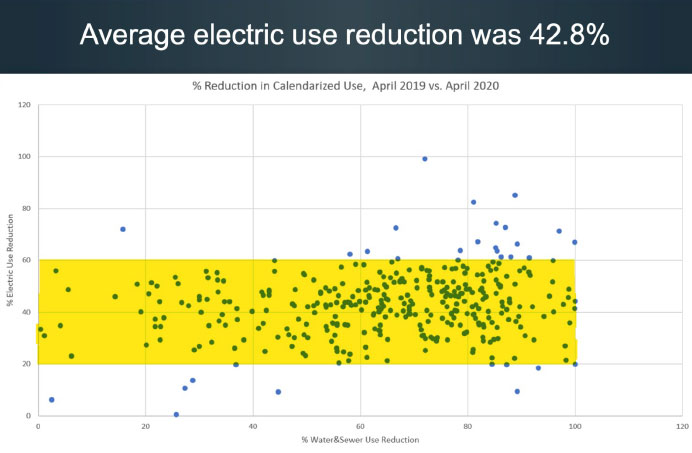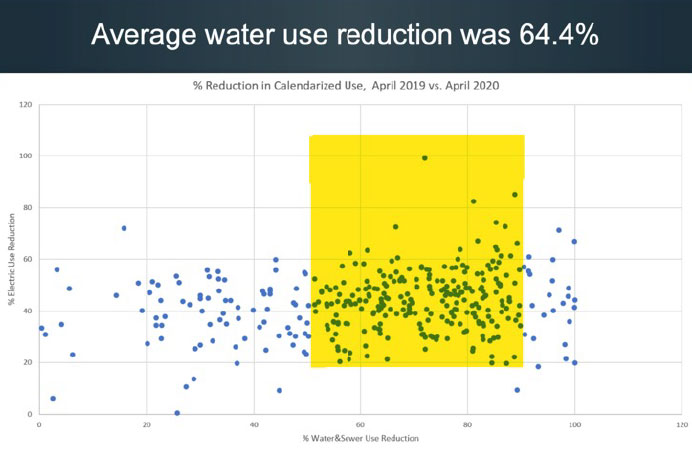When the COVID-19 shutdown was enacted in the U.S., the entire country was caught off guard. Plenty of documents and belongings were left in offices and on desks that wouldn’t be returned to for months, and schools everywhere rapidly worked to enact virtual learning.
The world is still feeling the effects of the pandemic and some workers may now be permanently remote. Work life and schedules are continuing to evolve making it even more challenging for energy managers to maintain some semblance of normalcy in the buildings they are responsible for. While we hope that we never experience a pandemic like COVID-19 again, there are many lessons Energy Managers can take away from the shutdown that can lead to significant energy-saving opportunities in the future.
Let’s review some real-life utility bill data from the shutdown and unpack what we can learn from this trove of information.
How COVID-19 Impacted Energy Use in School Districts
As terrible as COVID-19 has been, it did present schools, governments, and businesses with an opportunity to discover huge energy savings. But did they take full advantage? We wanted to understand how well building operators performed at setting back their building automation systems to adapt to the sudden lack of occupancy.
This process not only revealed energy savings top performers and laggards, but it also gave us enough information to draw conclusions for the future of building energy management.
For this exercise, we are focusing on utility data from 350 public school districts across the U.S. Since they were universally closed in April 2020, they provided an excellent test month of shutdown effectiveness.


Here are a few observations from the above graphs:
- Using water reduction as a proxy for occupancy reduction, a 64% reduction in occupancy drove a 43% reduction in electric usage. That suggests electric use for HVAC, lighting and equipment is zoned such that even low occupancy requires operation of large systems.
- Fifteen school districts had essentially zero occupancy, but electric reduction only averaged 45%, and several districts were below 25% reduction. This may indicate a lack of controls or inattentiveness and missed opportunities.
- The top performers, which can be found in the upper right quadrant of the graph, saved over 50% on electricity due to 75% or more occupancy reduction.
- The worst performing school district had 90% occupancy reduction but only 10% electric reduction.
How Energy Managers Can Learn from This Data
So, were energy managers able to significantly reduce energy use during the COVID-19 shutdown? In some cases, they were, but it’s obvious that there’s plenty of room for improvement. The data indicates that energy managers might not have access to the data they need to identify energy savings, and they may also not have the ability to control or shutdown their buildings.
However, there are several things energy managers can learn from this analysis. Even with some sense of normalcy returning post-shutdown, occupant schedules and building occupancy may be less consistent than in the past. Energy managers must adjust accordingly:
1. Be Aware of Other “Shutdowns”
Although COVID-19 was hopefully a once-in-a-lifetime occurrence, there are plenty of days each year that your buildings may be unoccupied. Weekends, holidays, and even events that cannot be predicted, like snow days.
If many school districts were not shut down properly for the pandemic, it’s likely that buildings in any industry are not being shut down properly for more regular occurrences. If you manage a school district or any group of buildings, and you don’t properly shut down for weekends or holidays, these missed energy savings can be significant.
2. Lighting, HVAC Systems Should Be Occupancy-Aware
Our data shows that a 64% reduction in occupancy only resulted in a 43% reduction in electric usage, so there’s clearly some miscommunication between occupancy and lighting and HVAC systems. Ideally, both lighting and HVAC systems should be occupancy-aware to truly maximize energy savings.
If there are days where occupancy is expected to be zero, there’s no need for lighting. Heating needs may be limited to freeze protection, and cooling may be limited to humidity control in sensitive areas, such as the library. Automating this zero-occupancy condition would be ideal, but even manually enacting this change could offer significant savings.
3. More Flexible Zoning is a Must
The data suggests that the school district buildings aren’t very flexible when it comes to zoning. Many schools can’t individually control every room; hallway lights are either on or off, and a whole wing of the building is either being heated or not.
If this is true for school buildings, it’s likely true for other industries as well. One occupant does not mean an entire floor or wing should be heated, cooled or lit up.
It may not be possible for energy managers to employ more flexible zoning using current technologies, but it’s certainly something to strive for in the years to come.
4. Energy Managers Must Be Vigilant
Speaking of current technologies, the wait for smarter buildings means energy managers must have boots on the ground and play a very active role in utility use reduction. Knowing a building’s expected occupancy for any given day should be a must. Additionally, energy managers should work to establish and improve benchmarks as they work to ensure utility bills match building occupancy.
5. Create a Challenge for Yourself
Don’t wait for an energy reduction mandate to begin finding ways to reduce energy consumption in your buildings. COVID-era utility data serves as a reminder that there’s always room to improve utility systems, processes, tracking, and reporting.
Big Savings Opportunities with EnergyCAP
EnergyCAP was able to collect and analyze all of this data thanks to our award-winning utility bill accounting and energy management software. If you review your utility data from the COVID shutdown and recognize similar issues to what we saw in public schools, you could benefit from our comprehensive energy management solution.
Our software is the only tool you need to identify inefficient buildings, track and evaluate the impact of your energy reduction efforts, and communicate results through live energy dashboards and robust reporting.
If you want to identify more energy savings opportunities and improve on last year’s benchmarks, contact us today to learn more about how EnergyCAP can help.
 Best-in-class portfolio-level energy and utility bill data management and reporting.
Best-in-class portfolio-level energy and utility bill data management and reporting.
 Real-time energy and sustainability analytics for high-performance, net-zero buildings.
Real-time energy and sustainability analytics for high-performance, net-zero buildings.
 A holistic view of financial-grade scope 1, 2, and 3 carbon emissions data across your entire business.
A holistic view of financial-grade scope 1, 2, and 3 carbon emissions data across your entire business.
 Energy and sustainability benchmarking compliance software designed for utilities.
Energy and sustainability benchmarking compliance software designed for utilities.




